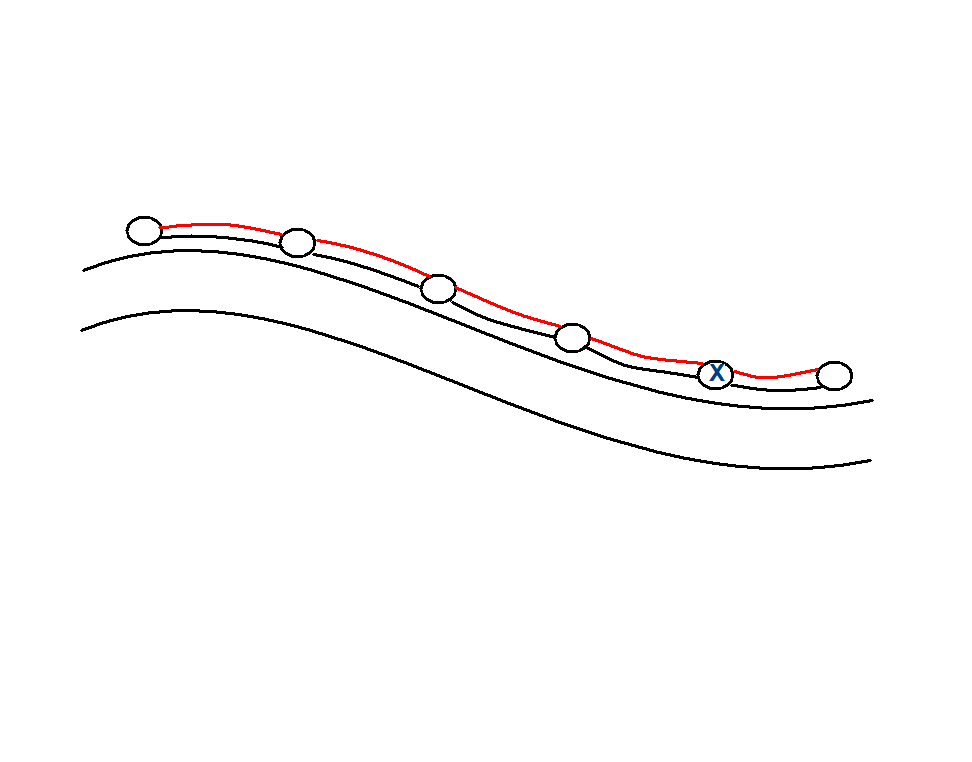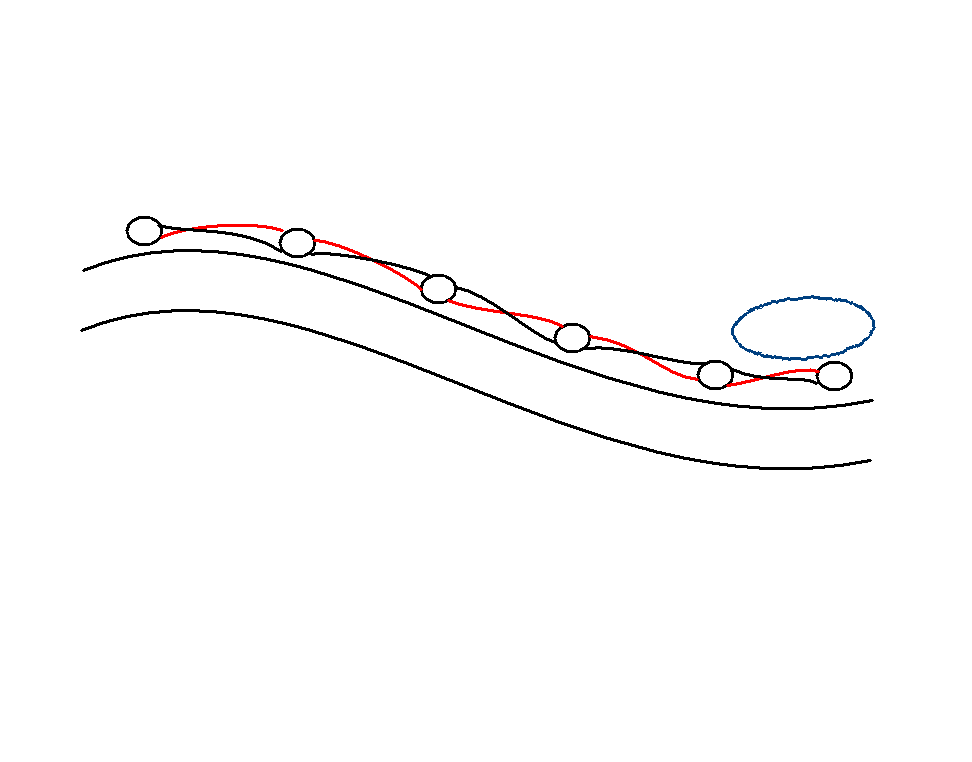| Vocademy |
Stereo and Surround Sound
Monaural sound
Monaural sound mixes all sounds into one channel. Each speaker will have the same sound coming from it and there is no illusion of directionality from the sounds. If two speakers are used with monaural sound, and the speakers are at equal volume levels, all of the sound will appear to come from a point half-way between the speakers.
There is an interesting consideration when having background sounds in a large venue. Let's say you are in charge of wiring the speakers for a resort where they want background music along all the walkways.
 |
|
|
Let's wire the speakers so they are in phase (phasing will be discussed below). You do this by wiring all the plus or red terminals together and all the minus or black terminals together, as you may rightfully expect is the correct way to wire the speakers.
|
As you approach the speakers from the right, the sound will appear to come from the first speaker.
 |
|
|
As you walk between the first two speakers, the sound will follow you and emanate from a point between the speakers.
 |
|
|
The sound may emanate from a point close to the path or some distance behind the speakers. Nevertheless, it will seem to come from a single point that moves with you as you walk along the path.
 |
|
|
You may find this pleasant, but it may also be distracting. Particularly, it may make people feel different than you would like. You want the sound to come from the background, not a specific place.
 |
|
|
Now, let's wire the speakers out of phase. This is done by alternating the wires to the plus or red and minus or black connectors.
 |
|
|
When you approach the speakers, the sound emanates from a vague area behind the speakers. You can hear the sound and tell what general direction it's coming from, but you can't pinpoint where it is.
 |
|
|
As you walk along, the sound follows you, but you still can't pinpoint where it is coming from.
 |
|
|
Since you can't tell where the sound is coming from, it doesn't draw your attention as it may when you hear it from a particular point.
 |
|
|
Now, the sound is just a vague background sound that may provide the atmosphere you want.
 |
|
|
The effect is not perfect. When close to a speaker you can hear the sound coming from it, but for the most part, the out of phase wiring creats a more pleasing sound than in phase speakers in this type of venue.
Stereo sound
Stereophonic or stereo sound is an attempt to recreate the directionality of sound. Typically, the term stereo refers to using two sound channels to ad directionality to the listening experience.
When using two channels (and thus two speakers), the relative loudness of a sound in the two channels will determine where the sound appears to come from. For example, the lead singer will usually be mixed equally into the two channels. His or her voice will then appear to come from a point directly between the speakers. If a sound is louder in the right speaker than in the left speaker, that sound will appear to come from the right of center. The louder the relative sound in the right speaker, the more the sound will appear to the right. Likewise, a sound that is louder in the left speaker will appear to come from a point to the left of center. Music is usually carefully mixed to cause sounds to come from specific places between the speakers, giving the illusion of a live performance.
By mixing sounds between the two channels and adding time delays, sounds can be made to come from the space that is not between the speakers. However, the effect is unpredictable and doesn't give accurate placement as simple stereo does.
Phasing
It is very important to wire the left and right speakers so that the cones move together; that is, the speaker cones move forward or backward together for a particular sound. This is referred to as correct phasing. If the speakers are wired so that one cone is moving toward the listener while the other is moving away from the listener, the sound will appear to come from everywhere between the speakers at once. The stereo effect is completely lost.
When wiring speakers, always pay attention to the polarity of the wires and connections. The connections may be labeled as + and - or may be red and black. The wires are usually red and black or one wire will have a stripe on it. These labels are to help keep the phasing correct. It is easiest to keep track if you always put + to red to stripe. Then the phasing will be correct.
Surround sound
Surround sound is any method used to put sounds in a 360-degree circle or a 3-dimensional space.
Sum-and-difference method
It is possible to encode a third channel into two-channel stereo with useable separation. Theoretically, the third channel will have only a 3 dB separation from the right and left channels, which would be barely perceptible. However, the psychoacoustic ability of the human auditory system does a good job of making the separation sound much better.
The third channel is mixed into the left and right channels by electronically subtracting the third channel from one of the front channels (inverting the phase of the third channel), but electronically adding the third channel to the other front channel (mixing without inverting). This has the same effect on the sound as if the speakers were wired out-of-phase where the third channel is concerned. Therefore, the third channel seems to come from everywhere between the left and right speakers; the listener cannot locate a definite source of the sound. It is simple to extract the third channel from the left and right channels. Much of the sound from the left and right channels remains with the extracted third channel, but the ear is good at ignoring it. The third channel is fed to speakers behind the listener for the surround effect. The sound for the third channel comes from all of the speakers but, because of it is out-of-phase in the front speakers, the listener's attention is captured by the in-phase sound coming from the rear speakers.
Many motion pictures and television shows have sum-and-difference surround sound encoded into the standard stereo channels.
The sum-and-difference third channel is very easy to extract. A single speaker with one wire connected to the red or + connection of the left channel and the other wire connected to the red or + connection of the right channel will emit the third channel.
For a detailed discussion on how sum-and-difference surround sound works, and how to decode it, go to:
https://vocademy.net/textbooks/AnalogCircuits/ss/surround.html
5.1 surround sound
Surround sound can also be achieved by using more than two discrete channels. 5.1 surround sound uses five completely separate channels. Two channels are to the front of the listener and two are behind the listener. For video presentations, a fifth channel at the center front helps keep dialog near the center, where the actors are. The ".1" of 5.1 refers to the presence a subwoofer channel in addition to the five main channels.
5.1 surround sound and similar systems, like 7.1 surround sound, are straight-forward. There are multiple discreet channels with a speaker for each. Each speaker is placed in a prescribed location (i.e., right-front, left-front, right-rear, left-rear and center front). All the installer has to do is make sure the correct wires go to each speaker and that the phasing is correct.
| Vocademy |